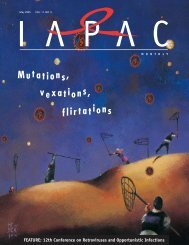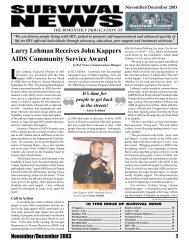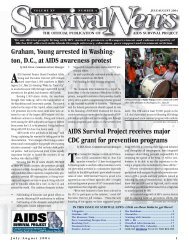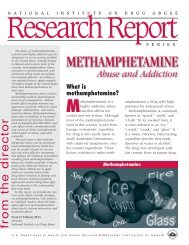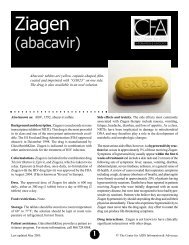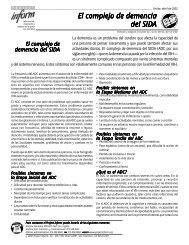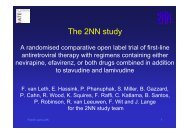HeAlTH INFormATioN & VieWs - CD8 T cells - The Body
HeAlTH INFormATioN & VieWs - CD8 T cells - The Body
HeAlTH INFormATioN & VieWs - CD8 T cells - The Body
You also want an ePaper? Increase the reach of your titles
YUMPU automatically turns print PDFs into web optimized ePapers that Google loves.
APeter Carlyle-Gordge takes a look at<br />
HIV art and HIV-positive artists in Canada.<br />
Here are four of our favourites.<br />
rtistic expression can be many things.<br />
It can be educational or a call to action. It can be soothing or shocking. It can<br />
reflect our times and passions. At its heart, however, it is an expression of the<br />
individual artist and his or her engagement with life.<br />
Artists have been involved in the HIV epidemic since its earliest days, when<br />
there was little to medicate and much to terrify. In the U.S., ACT-UP’s artistic offshoot<br />
Gran Fury helped push the epidemic in the face of the establishment,<br />
reminding us all that SILENCE=DEATH. Slowly, politicians and people began to<br />
get the message: Stop pretending that AIDS isn’t happening and start taking<br />
action against it. A too-complacent and bigoted world needed to be shocked into<br />
spending money, developing drugs and finding a cure.<br />
Canadian HIV-positive artists and their HIV-negative allies were also addressing<br />
the epidemic. General Idea—composed of Felix Partz, Jorge Zontal and AA Bronson—is<br />
one of the country’s best-known collectives of AIDS-activist artists. Active<br />
from 1967 to 1994, by which time both Partz and Zontal had died of AIDS, they<br />
were pioneers of early conceptual and media-based art.<br />
General Idea addressed the AIDS crisis with work that included some 75 temporary<br />
public art projects from 1987 to 1994. <strong>The</strong>ir major installation, “One Year<br />
of AZT/One Day of AZT,” was featured at the Museum of Modern Art in New York<br />
City and now resides in the collection of the National Gallery of Canada in Ottawa.<br />
<strong>The</strong> irreverent collective is perhaps best known for its 1989 AIDS graphic,<br />
inspired by Robert Indiana’s iconic LOVE image.<br />
While art was drawing attention to the unfolding epidemic, HIV-positive<br />
artists were living with a disease that, at the time, was usually fatal. For many,<br />
art was a way of processing this grim future and honouring those who had died<br />
of AIDS. Bob Sirman, director of the Canada Council for the Arts in Ottawa, was<br />
involved in Canada’s art community during those early years of the epidemic.<br />
Art can be therapeutic, he explains: “We all have great challenges to find meaning<br />
in life. I think art helps us to find a sense of order and meaning when huge<br />
challenges like HIV come up.”<br />
<strong>The</strong> introduction of effective antiretroviral therapy (ART) in 1996 meant that<br />
the virus could be brought under control and death could be averted. Art filled<br />
with rage, denial and sadness was replaced by life-affirming work. More<br />
recently, a new generation of HIV-positive artists is raising again the banner of<br />
arts-based activism, marching in the footsteps of their predecessors. <strong>The</strong> art of<br />
four people living with HIV, whose stories we share in the coming pages, illustrates<br />
this evolution of HIV and art in Canada over the past 30 years.<br />
Summer 2012 THE POSITIVE SIDE<br />
17



